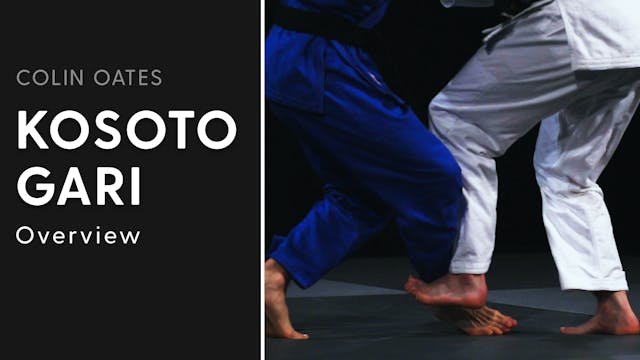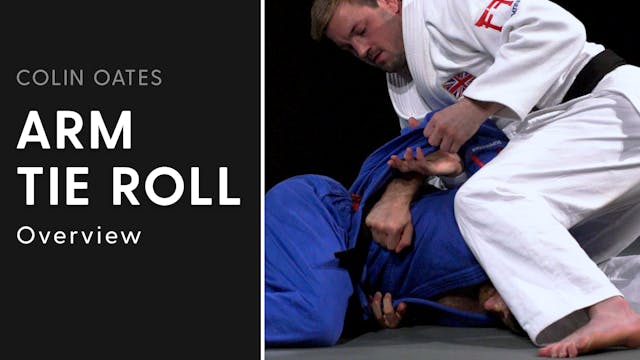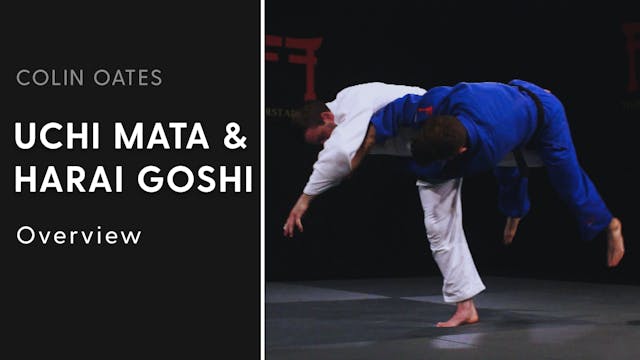Overview | Leg Escape | Colin Oates
Colin Oates
•
4m 31s
Colin Oates used Sumi Gaeshi not only as a way to score from standing, but as his primary method of initiating Newaza. His leg escape into Mune Gatame worked hand-in-hand with his Sumi Gaeshi. So much so that Oates would regularly attack with Sumi Gaeshi with the intention actually being to set-up his leg escape, rather than to score.
He says that in the latter part of his competitive career, if he got to the point where he had his opponent flat on their back, with his leg trapped, he felt he had a 75% chance of winning the contest. He regarded this as his ‘winning position’.
From a failed Sumi Gaeshi attack and in guard position, Oates reaches over his partner’s far shoulder with his left arm, taking their belt. He then comes under their armpit with his right arm, securing the top half of their body.
Oates points out that tempo, maintaining control and pressure are the three key components to making this technique a success. The tempo must be as quick as possible when gripping the belt and under the armpit. Once he has control he slows everything down as he climbs up on top of his partner and starts to work his leg out.
As he kicks the leg out, he goes back to full speed, spinning into the hold-down. The transition from standing into groundwork, and to having both hands on is fast. Now everything slows down as Oates takes control and starts building pressure. He does this by leaning and squeezing against his partner’s head, which he says is the most uncomfortable position for them to be in as they are fighting to breathe.
It’s the continual pressure that forces his opponent to release the leg, with their attention shifting from their legs to their head. A slow tempo means technique control and a build-up of pressure. But at the point you manage to escape the leg you must be as quick as possible, because this is the moment Uke will put everything into trying to roll and escape.
Another key point is to make sure that the partner’s body position changes from being on their back to their side. As control of the upper body must be maintained through both belt and armpit grip, this movement should be performed by the lower half of the body, using a shrimping action. This shrimping can also be used to help work the leg away from your partner’s, to the point at which it can be freed.
Once in Mune Gatame Oates says not to drop your weight and hold too tightly. If you do you will find that you are attached to your partner. And if they attempt to roll out, you may find you are going with them. Instead Oates likes to stay relaxed and give a bit of space between his partner’s chest and his. His left arm is free and mobile. It’s used to brace against attempted escapes and to counter big movements from the partner.
He says that this space gives the partner the impression that there is a way to escape. But all it ends up doing is sapping their energy, until eventually they give up.
Up Next in Colin Oates
-
Overview | Kosoto Gari | Colin Oates
Colin Oates has two excellent Kosoto garis which he uses against same stance opponents. The first is his sticky foot variation.
He says that sticky foot Kosoto gari is particularly useful against opponents who adopt an extreme stance.
It works on the basis of trapping your opponent in their mov...
-
Overview | Arm Tie Roll | Colin Oates
In the later part of his competitive career Colin Oates was regarded as one of the best lightweight Newaza technicians in the world.
Oates says that it was his groundwork that elevated him from an average international competitor to being inside the top five in his weight.
He had two techniques...
-
Overview | Uchi Mata & Harai Goshi | ...
Colin Oates says that when it comes to his Uchi mata and Harai goshi he has one key thing in mind, which is how to get a reaction from his partner.
It’s this reaction that generates the crucial momentum that he needs in order to throw.
His standard variations of both Uchi mata and Harai goshi a...



